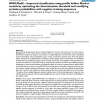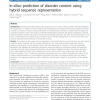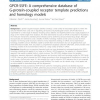35 search results - page 6 / 7 » Graphical Models of Residue Coupling in Protein Families |
BMCBI
2007
13 years 5 months ago
2007
Background: By virtue of their shared ancestry, homologous sequences are similar in their structure and function. Consequently, multiple sequence alignments are routinely used to ...
BMCBI
2004
13 years 5 months ago
2004
Background: The increasing number of protein sequences and 3D structure obtained from genomic initiatives is leading many of us to focus on proteomics, and to dedicate our experim...
BMCBI
2007
13 years 5 months ago
2007
Background: Profile Hidden Markov Models (HMM) are statistical representations of protein families derived from patterns of sequence conservation in multiple alignments and have b...
BMCBI
2011
12 years 8 months ago
2011
Background: Intrinsically disordered proteins play important roles in various cellular activities and their prevalence was implicated in a number of human diseases. The knowledge ...
BMCBI
2011
12 years 8 months ago
2011
Background: G protein-coupled receptors (GPCRs) transduce a wide variety of extracellular signals to within the cell and therefore have a key role in regulating cell activity and ...



